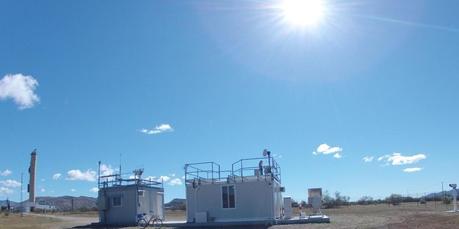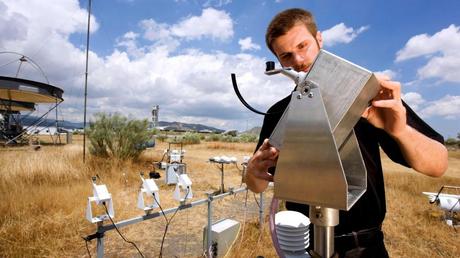
DLR and CIEMAT commissioned a meteorological research station at the Plataforma Solar de Almería site in southern Spain. (Credit: German Aerospace Center)
To find the optimal solar power plant locations it is important to know several things about the local weather conditions. How much solar energy reaches a power plant? Is the Sun often obscured by dust or other atmospheric particles? Researchers at the German Aerospace Center (DLR) and the Spanish research center, Centro de Investigaciones Energéticas, Medioambientales y Tecnológicas (CIEMAT) have just commissioned a meteorological research station at the Plataforma Solar de Almería site in southern Spain. Here, they are testing various methods and types of instrumentation. The requirements that this measuring equipment must satisfy are very demanding indeed; they must have the capacity to withstand a harsh desert climate, operate in remote regions, they must require little maintenance and must deliver accurate data.
The mirrors in solar power plants only reflect direct sunlight (direct radiation) precisely enough to reach the receiver, where it is converted into heat. Solar radiation scattered by water droplets or other particles that cause it to take an indirect path through the atmosphere is referred to as diffuse radiation. The mirrors are not able to focus this diffuse radiation, which means that it cannot be used for the power plant process. To enable operators to determine the best locations and to know how large the power plant must be to achieve a given output level, they need to have precise information about the meteorological conditions at each site. In the METAS (Meteorological Station for Solar Technologies) research project, researchers are trying out various measuring methods and are collecting data that should facilitate the planning of an optimum power plant. Scientists are also working on international guidelines and standards to ensure that this data is readily comparable on a worldwide basis.
Solar power plants are used mainly in sunny regions, for the most part in desert terrain. Here, the main problem is caused by small particles known as aerosols that tend to congregate in atmospheric layers close to ground level and diminish the power of direct solar radiation. These particles also tend to accumulate on the mirrors in power plants, contaminating them and causing their performance to deteriorate. For this reason, reliable meteorological data is of paramount importance in the search for suitable locations. In this project, researchers are testing which measuring instruments are best suited to operating in a harsh desert climate with little maintenance.

Measuring stations provide data on solar radiation and pollution. (Credit: German Aerospace Center)
In tower power plants, the distance that light rays have to travel from the mirrors to the receiver at the top of the tower on some existing commercial power stations can be as much as several kilometers. Rays of sunlight can be significantly absorbed and scattered over this kind of distance in places with a high concentration of aerosols. With a system known as LIDAR (LIght Detection And Ranging), comprising a high-energy laser used with a telescope, scientists are able to measure aerosol concentration and its vertical distribution. With this same instrument, researchers can also distinguish whether these particles are sea salts, mineral desert dust or soot. “Regions with a clear atmosphere are suitable locations for tower power plants with a large heliostat field. Regions with relatively high aerosol concentrations in the atmosphere close to ground level may be better suited to the construction of several smaller power plants,” says Natalie Hanrieder, a scientist at the DLR Institute for Solar Research at the Plataforma Solar de Almería. The results of her work will be incorporated into existing simulation programs for the optimal design of power plants.
Measuring devices and how they work
Rotating Shadowband Irradiometer (RSI). Measures the global and the diffuse solar radiation with the help of a ‘shadowband’ that rotates around the sensor. From this, the level of direct solar radiation that is important for concentrating solar power plants can be determined.
LIDAR (LIght Detection And Ranging). High-energy laser transmits radiation with various wavelengths vertically upwards into the atmosphere. A neighbouring telescope detects the molecules, aerosols and cloud particles in the atmosphere using the backscattered radiation.
Sun photometer. Measures the direct solar radiation by tracking the path of the Sun throughout the day and by quantifying the various wavelength components of the solar radiation. That makes it possible to analyse the prevailing opacity of the atmosphere resulting from the presence of aerosol particles between the photometer and the Sun, as well as the concentration of certain components in the atmosphereen.
Ceilometer. This device sends a laser beam vertically upwards into the atmosphere, which enables it to determine the altitude and thickness of different cloud layers using the laser radiation backscattered down to Earth’s surface by water droplets in the clouds.

